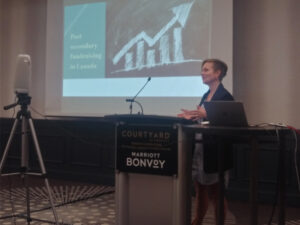Excelling at giving communications in higher education

By Sharon Aschaiek | June 29, 2022
With public funding for higher education in Canada continuing to shrink, charity has never been more important to post-secondary schools.
As the Canadian Union of Public Employees notes, the share of operating revenue universities receive from government has decreased to 50% from 80% over the last 30 years. We must advocate for more government investment to keep Canada’s post-secondary sector globally competitive, argues University of Waterloo president and vice-chancellor Vivek Goel.
Schools have been taking matters into their own hands by ramping up their efforts to attract donations. A recent survey found that last year, more than 250,000 individuals, foundations, trusts, corporations and other groups gave more than $1.7 billion to the country’s post-secondary institutions.
Christy Miller says there are some key ways universities and colleges can be more effective in attracting gifts, grants and donations of money, property, equipment or other contributions. A 20-year higher education and non-profit advancement professional who most recently directed alumni and donor engagement at the University of Saskatchewan, Miller shared her insights on the topic in the presentation “Turn your communications into cash: Writing for Development” at last month’s 6th Annual Marketing & Communications for Post Secondary Conference in Toronto.
Something important to keep in mind, Miller said, is the difference between what donors say they want—digital communications and fewer asks—and what they actually respond to, according to practice: direct mail solicitations, in-person visits and multiple asks. So keep this in mind when crafting your giving campaigns and maintain confidence in your outreach efforts.
Follow the BOY rule
A critical aspect of donor communications is situating the prospective donor at the centre of the giving proposal, Miller says. She advises following the “BOY”—Because Of You—rule in copywriting to demonstrate the critical role a potential donor can play in helping to advance an important cause or project at your institution.
“People give not because of who you are, but because of who they are,” says Miller, who is currently a consultant with Global Philanthropic Canada. “Make the donor the hero of the story. Use “you” a lot in your content.”
Part of this work involves understanding what might motivate someone to give to your school. For instance, Miller says, alumni typically donate because they feel pride in their alma mater, out of a sense of nostalgia, a belief in their program, confidence in the institution’s leadership, and/or a desire to pay forward their own opportunity for success to other students. Shape your asks in a way that taps into these desires or beliefs, Miller says.
Strike an emotional chord
Also essential is drafting copy that creates emotional resonance. This means reflecting the positive impact of a donation on recipients—how it will make a difference to students from disadvantaged backgrounds, enable more meaningful learning opportunities at the institution, or otherwise improve lives or communities.
“It starts with the heart. You have to move donors emotionally,” Miller says. “Get potential donors to feel something, and tell them more about how they can act.”
To make your giving communications easy to read and act on, Miller advises the following:
- Create copy that is at Grade 6 reading level—use conversational, straightforward language with simple, concise sentences that includes the active voice and strong verbs, and avoids jargon or acronyms. “Ask yourself, “Would my grandmother understand it?” Miller says.
- Focus copy on one person who has been helped by a donation, so that it easier for the reader to understand the impact.
- Highlight the benefits of upstream investment—addressing an issue/supporting a cause early on versus when it becomes an emergency, e.g. supporting medical/vaccine research that can prevent a pandemic.
- Make it skimmable: include photos—images of people work best, or else dynamic or compelling action shots—captions, headlines, decks, subtitles, pull quotes.
- If possible, support your pitch by including links to news reports that back up the importance of the cause for which you are fundraising.
Finally, she says, as you develop your donor communications, remember that the narrative should be less about soliciting funds and more about building a relationship and inviting them to be a part of something important.
“Fundraising is about work that urgently needs doing. Don’t start with asking for money,” she says. “Rather than educate donors about your work, take them on a journey.”